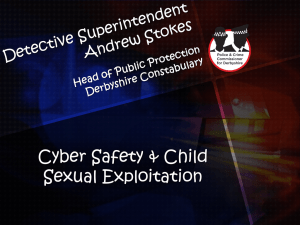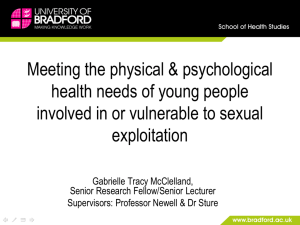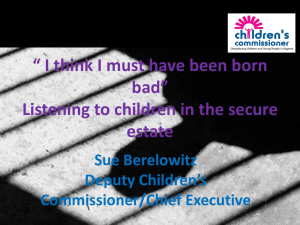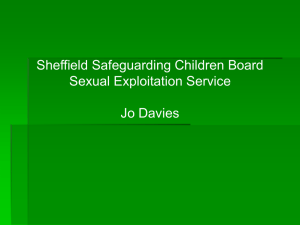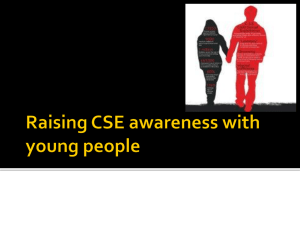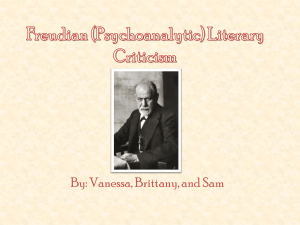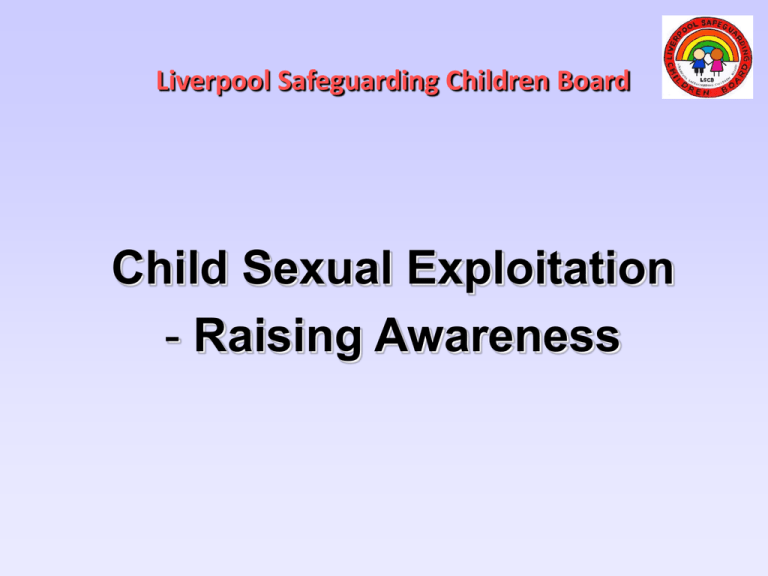
Liverpool Safeguarding Children Board
Child Sexual Exploitation
- Raising Awareness
Housekeeping
Welcome
&
Introductions
AIM of the Training
To increase participants awareness of Child
Sexual Exploitation as a form of Sexual Abuse
and enable them to identify Vulnerability and
Risk Factors
Learning Outcomes
• Have an understanding of the definition of Child Sexual
Exploitation
• Recognise typical indicators of sexual exploitation in
children and young people
• Have an understanding of the Grooming Process
• Understand the vulnerabilities that lead to Child Sexual
Exploitation
• Be able to identify Children and Young People who may be
at Risk
• Be clear on how, when and why to share information
• Discuss ways in which to communicate and engage with
vulnerable young people
Evaluating learning
Please could you answer the five questions on
your evaluation form
BEFORE THE COURSE only!!
Guidelines for Safe Learning
•
•
•
•
•
•
•
•
Confidentiality
Listen/One speaker at a time
Respect
No such thing as a “silly” question
Responsible for your own learning
Okay to get things “wrong”
Okay to have feelings
Time/Mobiles
Exercise
Group Task:
What is the definition of CSE?
In your groups try to come up with a definition
DEFINITION OF CHILD SEXUAL EXPLOITATION
The definition of Child Sexual Exploitation which will be utilised across Merseyside will be:
Sexual exploitation of children and young people under 18 involves exploitative situations,
contexts and relationships where young people (or a third person or persons) receive
‘something’ (e.g. food, accommodation, drugs, alcohol, cigarettes, affection, attention, gifts,
money) as a result of them performing, or others performing on them, sexual act or
activities.
Child sexual exploitation grooming can occur through the use of technology without the
child’s immediate recognition; for example being persuaded to post sexual images on the
Internet/mobile phones without immediate payment or gain. In all cases, those exploiting
the child/young person have power over them by virtue of their age, gender, intellect,
physical strength and/or economic or other resources.
Violence, coercion and intimidation are common, involvement in exploitative relationships
being characterized in the main by the child or young person’s limited availability of choice
resulting from their social/economic and/or emotional vulnerability”
Safeguarding Children and Young people from Sexual Exploitation - Supplementary
guidance to Working Together 2006
Group Task:
Signs and Indicators
Video Clip
In your groups, try to identify the key signs and
indicators of sexual exploitation
The following signs and behaviour are generally seen
in children and young people who are already being
sexually exploited.
• Missing from home or care.
• Physical injuries.
• Drug or alcohol misuse.
• Involvement in offending.
• Repeat sexually-transmitted infections, pregnancy and
terminations.
• Absent from school.
• Change in physical appearance.
Also..
• Evidence of sexual bullying and/or vulnerability through the
internet and/or social networking sites.
• Estranged from their family.
• Receipt of gifts from unknown sources.
• Recruiting others into exploitative situations.
• Poor mental health.
• Self-harm.
• Thoughts of or attempts at suicide.
WARNING SIGNS AND
VULNERABILITIES CHECKLIST
The following have been identified as typical vulnerabilities:
• Living in a chaotic or dysfunctional household (including
parental substance use, domestic violence, parental mental
health issues, parental criminality).
• History of abuse (including familial child sexual abuse, risk of
forced marriage, risk of ‘honour’- based violence, physical and
emotional abuse and neglect).
• Recent bereavement or loss.
• Gang association either through relatives, peers or intimate
relationships (in cases of gang associated CSE only).
• Attending school with young people who are sexually
exploited.
• Learning disabilities.
• Unsure about their sexual orientation or unable to disclose
sexual orientation to their families.
• Friends with young people who are sexually exploited.
• Homeless.
• Lacking friends from the same age group.
• Living in a gang neighbourhood.
• Living in residential care, or are looked after.
• Living in hostel, bed and breakfast accommodation or a foyer.
• Low self-esteem or self-confidence.
• Young carer.
• Evidence shows that any child displaying several
vulnerabilities from the above lists should be considered to be
at high risk of sexual exploitation. Professionals should
immediately start an investigation to determine the risk, along
with preventative and protective action as required.
• However, it is important to note that children without preexisting vulnerabilities can still be sexually exploited.
Therefore, any child showing risk indicators in the second list,
but none of the vulnerabilities in the first, should also be
considered as a potential victim, with appropriate assessment
and action put in place as required.
All organisations and agencies need to take
account of the vulnerabilities checklist and
work together to identify children showing
the warning signs of, or who are vulnerable to,
child sexual exploitation, and act accordingly:
National context
Oxford March 2012
Operation Bullfinch
"It is clear there was an organised and sophisticated gang
of predatory men who set up a criminal business of,
corrupting, isolating and abusing the girls and selling them
for sexual purposes.
The girls have lived through hell and for them to come to
court and give evidence has been nothing short of
incredible. The strength and fortitude they have shown has
been inspirational. I only hope they can draw a line under
this traumatic period of their lives and move forward.”
Rochdale May 2012
•Nine men who ran a child sexual exploitation ring in Greater
Manchester have been jailed.
•The men from Rochdale and Oldham, who exploited girls as
young as 13 were given sentences ranging from four to 19
years- 77 years in total.
•They were found guilty of offences including rape, trafficking
and conspiracy to engage in sexual activity with a child.
•Liverpool Crown Court heard the group plied five victims with
drink and drugs and "passed them around" for sex.
•The girls were abused at two
takeaway restaurants
Stockport
October 2013
Three men jailed for sexually abusing two vulnerable girls
in Stockport.
The two victims were aged between 14 and 16 when the
abuse took place between 2008 and 2011.
The abuse came to light after social workers in Stockport
became concerned about young girls who were going
missing from home.
Myths Versus Reality
Myth: There are very few ‘models’ of CSE
Reality: The grooming and sexual exploitation of young people
can take many different forms.
Myth: It only happens in certain ethnic/cultural communities
Reality: Both perpetrators and victims are known to come from a
variety of ethnic and cultural backgrounds.
Myth: It only happens to children in care
Reality: The majority of victims of CSE are living at home.
However, looked after children account for a disproportionate
number of victims and can be particularly vulnerable.
Myth : It only happens to girls and young women
Reality: Boys and young men are also targeted as victims of CSE
by perpetrators.
Myth : It is only perpetrated by men
Reality: There is evidence that women can be perpetrators of
this crime too. They may use different grooming methods but
are known to target both boys and girls.
Myth : It only happens to young teenagers by men
Reality: Peer-on-peer child sexual exploitation happens too and
this can also take various different forms.
Myth : Parents should know what is happening and be
able to stop it
Reality: Parents may be unlikely to be able to identify what is
happening: they may suspect that something is not right but may
not be in a position to stop it due to the control, threats or fear
of the perpetrators.
Myth : Children and young people can consent to their own
exploitation
Reality: A child cannot consent to their own abuse.
Identifying Perpetrators
• Perpetrators come from all ethnicities but each area can have a ‘profile’ –
profiles can change
• All communities
• All ages
• They are both male and female
• No one group dominates CSE
• Internet/trafficking/personal gratification
• They are visible in every day life
• They are often articulate/Savvy
• Not all are involved in commercial exploitation
• (Not much is known about those who buy young people from exploiters
and groomers)
Identifying Perpetrators
• ‘Its all about money – money is tight…jobs are
hard to come by, stealing…well its got more
consequences.’
• ‘Young girls are better…they are more
vulnerable, they listen to you and they fall for
it. Older girls won’t fall for it.’
(Some views expressed during the November 2011 Dispatches programme –
Britain's sex gangs.)
BREAK
CSE in Liverpool
Nikki Owens
CSE coordinator
• How many young people are being/ at risk of
sexually exploited in Liverpool?
• Who is most at risk? (links with Missing)
Principles of effective practice
1.
2.
3.
4.
5.
The child’s best interests must be the top priority
Participation of children and young people
Enduring relationships and support
Comprehensive problem-profiling
Effective information-sharing within and between
agencies
6. Supervision, support and training of staff
7. Evaluation and review
“If only someone had listened” | Office of the Children’s Commissioner’s Inquiry into Child
Sexual Exploitation in Gangs and Groups – Final Report November 2013
Any Questions?
John Rooney
Police Missing Person Coordinator
The Police response to CSE in Merseyside
Current Legislation
•
•
•
•
•
•
•
•
•
•
Child Abduction Act 1984
Children Act 1989/2004
Children Leaving Care Act 2000
Adoption & Children Act 2002
Education Act 2002
Homeless Act 2002
Sexual Offences Act 2003
Asylum & Immigration Act 2004
Domestic Violence Crime & Victims Act 2004
UN Convention on the Rights of the Child
Sexual Offences Act 2003
A major piece of law reform creating many offences
concerning:
Rape, sexual assault, child sexual offences, abuse of a
position of trust, familial child sexual offences,
offences concerning persons with mental disorders,
child prostitution and pornography, exposure and
voyeurism, offences in a public lavatory, offences
outside of the UK.
Some of the Other New Offences
• Meeting a child following sexual grooming etc, (section 17)
• Sexual activity with a child family member
• Indecent photographs of children 16 & 17 years of age
• Abuse of a position of trust
• Administering a substance with intent
• Trafficking into, within and out of the UK
Grooming
Offences in relation to grooming will be committed by an
adult where all the following elements are present
• An adult who is 18 or over, travels to meet or actually
meets with a child who is 16 or younger
• The adult intends to commit a sexual offence against the
child – evidence may be condoms bought, text messages
sent etc
• The adult has communicated with the child on at least two
occasions beforehand
• The adult does not reasonably believe that the child is 16 or
over
Any Questions?
Child exploitation and digital technologies
“SEXTING”
• When a young person takes an indecent image of them self
and sends this to their friends or boy / girlfriends via mobile
phones.
• By having in their possession, or distributing, indecent images
of a person under 18 on to someone else – young people are
not even aware that they could be breaking the law as these
are offences under the Sexual Offences Act 2003.
What are our young people telling us?
Key findings for secondary school age children:
• Among year 9 pupils sexting awareness, rather than practice, was
prevalent
• Sexting usually took place at the formation of, or during, a
relationship.
• Girls are far more likely than boys to be asked for a picture, boys
are far more likely to volunteer one
• Further distribution of an image beyond the intended recipient
occurs frequently
• Girls “sext” to gain attention, or to please boys. Boys ask for
images “because they can” and will ask girls until one sends a
picture.
Research undertaken by Professor Andy Phippen Plymouth University
- Visit to Liverpool Schools 4th-6th June 2013
Differences between Liverpool young people and others
spoken to in other parts of the country:
• A slightly younger starting point for sexting incidents to start
occurring. In both secondary schools pupils spoke about this
sort of thing beginning in year 7 when they move from
primary
• There was a higher level of maturity and resilience from some
girls in dealing with issue around sexting
• There was a greater awareness of the reasons for sexting
• There was a larger gender imbalance in terms of a willingness
to talk about these issues.
Research undertaken by Professor Andy Phippen Plymouth University Visit to Liverpool Schools 4th-6th June 2013
• Bullying often results from the generation and distribution of
an image. The duration of the bullying depends on the
popularity of the victim (i.e. the more popular the victim, the
less likely it is that bullying will last for long)
• Turning to a teacher or parent for help is unlikely due to a fear
of being told off or judged
• Attitudes toward sexting are somewhat mundane, it happens
and will continue to happen
• For boys of this age, pornography consumption is widespread
and they are very open in talking about it
Research undertaken by Professor Andy Phippen Plymouth University
–Visit to Liverpool Schools 4th-6th June 2013
Social Media – Current Top 3
• Hot or Not
• Guess the Body Part
• Flash for Cash
What are your experiences of young people
and social media?
How can we best engage with and support
children and young people?
Group discussion
LUNCH BREAK
Models of Child Sexual Exploitation
1.
2.
3.
4.
5.
Street Grooming/peer on peer
‘Boyfriend’ model
‘Party’ model
Internet grooming
Organised/networked sexual exploitation or
trafficking
The Grooming Line
• Targeting Stage
• Friendship Forming Stage
• Loving Relationship Stage
• Abusive Relationship Stage
Grooming Process
Targeting
Stage
Observing the young
person
Selection of young person
Befriending – being nice,
giving, caring, taking an
interest, giving
compliments etc.
Gaining and developing
trust
Sharing information about
young people between
other abusive adults
Friendship Forming
Loving
Stage
Relationship Stage
Making young people feel
special and spending time
with them
Giving gifts and rewards
Listening and
remembering
Keeping secrets
‘No-one understands you
like I do’; being their best
friend
Testing out physical
contact – accidental
touching
Offering protection and
being there for them
Abusive
Relationship Stage
Being their boyfriend /
girlfriend
Becomes an ‘unloving’
sexual relationship
Establishing a sexual
relationship
Withdrawal of love and
friendship
Lowering their inhibitions –
eg showing them
pornography
Reinforcing dependency
on them – stating young
person is ‘damaged
goods’
Engaging them in
forbidden activities – eg
going to clubs, drinking,
taking drugs
Being inconsistent –
building up hope and then
punishing them
Isolation from family and
friends
Trickery and manipulation
– ‘you owe me’
Threatening behaviour
Physical violence and
sexual assault
Making them have sex
with other people
Giving them drugs
Playing on the young
person’s feeling of guilt,
shame and fear
Multi Agency Response to Child Sexual
Exploitation
Siobhan Sullivan/Ian Bowden
Liverpool Safeguarding Unit
Children’s Services Flowchart 1
Agency representative becomes
concerned that a child may be at risk
of CSE
Agency representative urgently
discusses the concern with
safeguarding lead
Agency representative and Safeguarding
lead ensure that CSE 1 Referral Form and
CSE 2 Assessment Form are completed
Agency representative and Safeguarding lead ensure that
CSE 1 and CSE 2 forms are forwarded to child’s allocated SW
if known or to Careline if not aware of allocation
Agency representative completes
CSE 1 and CSE 2. Forwards to both
child’s SW if known or to Careline if
not aware of allocation
Allocated SW
identifies
concerns
SW is aware of CSE
concerns in respect
of an open case
Discuss with Team Leader.
Decision made as to whether to
undertake Strategy Discussion
with police
SW ensures that
completed CSE 1 and
CSE 2 are sent to DO at
Safeguarding Unit
SW is informed of
CSE concerns
Careline is informed of
CSE concerns
Where identified
child is open to CSC
information is
recorded on Capita
and SW informed
Careline ensures completed
CSE 1 and CSE 2 forms sent to
Duty Safeguarding Officer at
Safeguarding Officer
Mailbox monitored and referral
forms sent to Duty Safeguarding
Officer each day
Where identified child is not
open case to CSC, Careline team
leader makes decision within 24
hrs whether to undertake
strategy discussion with police
and generate referral for
assessment
Children’s Services Flowchart 2
Mailbox monitored and referral forms sent to Duty
Safeguarding Officer each day.
Duty SO assesses information
referred and liaises with SW
and/or Team Leader
Information
referred indicates
risk of SE
Information indicates that person
with PR is contributing to the risk
or is negligent in not acting to
safeguard the child
Duty SO applies
threshold for
strategy meeting
Duty SO and team leader agree the
need to convene CP conference
CSE strategy
meeting takes
place as soon
as practicable
Information presented
does not indicate
immediate risk of CSE
or risks associated
with parenting
CP conference takes
place as soon as
practicable
DUTY SAFEGUARDING OFFICER REFERS CHILD TO MACSE
Referral pathway for CSE concerns
Flowchart
Multi Agency Information sharing
• Where the risk is not immediate, referrals should be made to
the multi agency CSE meeting using the CSE1 form
• The referrer should also completed the initial risk assessment,
in accordance with the Risk Assessment CSE 2 to prioritise the
level of risk for each child or young person referred.
• Any actions allocated and information received at the meeting
will be documented clearly using the CSE 3.
Multi Agency Child Sexual
Exploitation Meeting (MACSE)
Purpose:
•To establish the exact nature of the concerns (and to agree what
information to give to parents) and to plan enquiries (and decide
who should handle them.)
•To gather and share information (including assisting the police in
any criminal investigation) and identify gaps in information.
•To agree on action to determine how the case should be managed
•Appropriate support in place for the C/YP
•To assign tasks to address the concerns (which must be completed
before first/next review.
Strategy Discussion and Strategy
Meetings
• A Strategy Discussion must take place in every situation where
there is reasonable cause to suspect that a child is suffering or
is likely to suffer Significant Harm, either following a referral
or where concerns about Significant Harm emerge in respect
of a child receiving support under Section 17 of the Children
Act 1989 as a Child in Need.
• Children’s Social Care may also convene a Strategy Meeting.
Liverpool Procedures online October 2013
Risk Factors
• Most common issues are vulnerability, low self
esteem and poor self image.
• Vulnerability is identified and targeted by
offenders, whether the young people live at home
with their family, looked after (in care) or whether
they have run away.
• Looked After Children (LAC) or those running away
from home are recognised as being much more at
risk of being targeted due to isolation.
As an individual
what do I need to do?
•
•
•
•
•
•
Recognise there is an issue
Take responsibility – ACT NOW – CSE referral
Line management – referral feedback
Pro active approach - preventative work
Ensuring appropriate training/dissemination
Support for parents/carers in place?
Above all ensure a young person centred approach
and that the young person is fully informed at all
times.
Any Questions?
Lesley Stopforth & Gaynor Little
Action for Children
Liverpool Young Runaways
Carla’s Story
Task 1
• In your groups please discuss and answer the question that is
on the piece of paper in front of you.
• The are 3 questions for part 1 of Carla’s story. Each group has
all 3 questions.
• Could one person scribe and one person feed back to the
larger group after please.
• You have 10 minutes to discuss the statement and write down
your answers.
Carla’s story - part two
Task 2
• Now you have heard the end of Carla’s story please answer
the next question you have in your group.
• The are 3 questions for part 2 of Carla’s story each group has 1
each.
• Could one person scribe and one person feed back to the
larger group after please.
• You have 10 minutes to discuss the statement and write down
your answers.
Consent
• C & YP may claim to be acting voluntarily and
may not see themselves as a victim – In reality
this is not voluntary or consenting behaviour
• What is your understanding of consent?
“There was great confusion among young people about
the meaning of consent. Analysis of case files provided
illustrations of children struggling to communicate or
there was great confusion among young people about
the meaning of consent.
Analysis of case files provided illustrations of children
struggling to communicate or comprehend whether
they were consenting to the activity in which they had
been involved:”
The report from ‘Office of the Children’s Commissioner, Inquiry into Child
Sexual Exploitation In Gangs and Groups’ 2013
Consent & Coercion
•
•
Throughout Inquiry, the panel was presented with confused and inconsistent
understanding on the part of both professionals and young people of the concept of
consent to sexual activity:
Children and young people who were being sexually exploited were frequently described
by professionals in many localities as being “promiscuous”, “liking the glamour”, engaging
in “risky behaviour” and being generally badly behaved.
Some of the most common phrases used in the call for
evidence submissions to describe the young persons
behaviour were:
• The young person is “prostituting herself”.
• She/he “places her/himself in vulnerable situations”.
• She/he is “drawn to it”.
• She/he is “risk-fuelled”.
• They are a “danger to themselves”.
• She/he “refuses to acknowledge risks”.
• She/he is “sexually available”.
• She/he is “asking for it”.
• Labelling reflects a worrying perspective held by a number of
professionals, namely that children are complicit in, and
hence responsible for, their own abuse.
• Professionals often demonstrated a lack of awareness of the
impact on children of living in dangerous environments and of
the consequences for the child or young person of saying
“no”.
• Numerous testimonies from young people provided evidence
that failure to comply with demands for sex, were likely to
result in serious harm to them and/or to their family.
• It was clear that, even when young people were saying that
they were agreeing to sex, this was happening under
manipulative and coercive circumstances.
• However, coercion was not always identified, or even
considered, by professionals.
• Professionals need to be clear – that sexually-exploited
children are children first and foremost, and that their
experience in these circumstances is not consensual, but
abusive.
England and Wales
• The age of consent to any form of sexual activity is 16 for both men and
women.
• The Sexual Offences Act 2003 introduced a new series of laws to protect
children under 16 from sexual abuse. However, the law is not intended to
prosecute mutually agreed teenage sexual activity between two young
people of a similar age, unless it involves abuse or exploitation.
• Specific laws protect children under 13, who cannot legally give their
consent to any form of sexual activity. There is a maximum sentence of life
imprisonment for rape, assault by penetration, and causing or inciting a
child to engage in sexual activity. There is no defence of mistaken belief
about the age of the child, as there is in cases involving 13–15 year olds.
• Read more at http://www.fpa.org.uk/factsheets/law-onsex#K6xm4RFxY7AQxXy7.99
Statutory definition of consent from CPS;
• Section 74 defines consent as 'if he agrees by choice, and has
the freedom and capacity to make that choice'.
Prosecutors should consider this in two stages. They are:
• Whether a complainant had the capacity (i.e. the age and
understanding) to make a choice about whether or not to take
part in the sexual activity at the time in question.
• Whether he or she was in a position to make that choice
freely, and was not constrained in any way. Assuming that the
complainant had both the freedom and capacity to consent,
the crucial question is whether the complainant agrees to the
activity by choice.
• The question of capacity to consent is particularly relevant
when a complainant is intoxicated by alcohol or affected by
drugs.
Mia’s story
‘Mia’, a young woman of ‘Mixed’ ethnic heritage, disclosed to professionals
that she had been sexually exploited for two years by a local street gang, from
the age of 11 to 13.
When Mia made her disclosure she named a number of other girls from a
mixture of ethnic backgrounds, who were either present at instances of abuse
or who were also abused by members of the gang.
Some of the girls named were interviewed by the police. The girls, who had
witnessed the abuse, or previously been friends with Mia, stated that Mia
had consented on all occasions that they had witnessed. They stated she was
a ‘slag’.
One of the other girls, who had also been abused by the street gang, was
shown phone footage of her assault. She informed the police that she did not
want it to happen, but that she had consented and therefore did not want to
proceed with a complaint.
Children’s Understanding of Consent
• The report by the Office of Children said children were confused for many
reasons. For example, given their previous experiences of child sexual
abuse.
• Influenced by where they lived and with whom they mixed.
• Influenced by the fact that they had previously committed offences. They
assumed they had to comply with the abuse or might turn them in to the
police.
• Others understanding
was informed by wider social messages,
stereotypes and structures.
• Grooming process distorted some children’s understanding of consent
• Feelings of powerlessness and resignation were common
• For all of these reasons, some children simply did not feel that there was a
choice
Rochelle’s Story
Over the two years that ‘Rochelle’ was sexually exploited by a street gang,
several forms of technology were used to abuse and control her. Members of
the street gang would routinely steal her phone and then tell her that if she
wanted it back she would have to come and meet them.
When Rochelle went to locations to collect her phone she would be told that
she must perform oral sex on one or multiple members of the gang or they
would anally rape her, in order to get her phone back.
Members of the gang, and their sisters, would send Rochelle abusive and
threatening text messages throughout the abusive process. These on-going
threats scared Rochelle, meaning she was always afraid of what might happen
to her. Instances of abuse were filmed by members of the gang, and Rochelle
would be told that if she did not comply with the demands of gang members,
footage would be circulated around her school.
When Rochelle disclosed the abuse she was threatened over Facebook. The
young men who were abusing Rochelle would communicate frequently using
an instant messaging service, and individual members of the street gang
would also use it when they were with her to invite others to meet up and
take part in the abuse.
A person consents if they agree by CHOICE
and have the FREEDOM and the CAPACITY to
make that choice……
The young person’s
perspective
Young person’s view:
Reality:
Society sees:
Girl
Abused child
Prostitute
Boyfriend
Abusing adult
Pimp
His friend
Child sex offender
Paedophile
Boys & young men
• SE services report that a third of the referrals relate
to boys and young men.
• It can be more difficult to detect cases of SE with
males as they are generally harder to work with and
less likely to disclose.
• It is problematic as issues of sexuality may well come
to the fore.
• Society’s perceptions of how boys & young men
should behave is a barrier i.e. boys don't cry
‘What Information do children and young
people need about CSE?’
•
•
•
•
•
•
How to recognise if it is happening to you
How serious it is
What it is / Different ways in which is can be happening
How to get help / Lots of different options
Information about the risks around alcohol and drugs
Reassurance that if it is, or has, happened to you that you
can get help and support
• A really strong message to just say ‘NO’ if something
doesn’t feel right to you
Parents and Carers Perspective
• They see a change in behaviour
• Could see it as teenage behaviour/a rebel/hanging with the wrong
group?
• Experimenting with drugs and alcohol
• Isolated, angry, emotional
• Stressed
• Bad parent – inadequacy?
• At breaking point – Breakdown in adult relationships – rippling effects
throughout the family
• Bad behaviour – Had enough, someone else deal with this?
• Not my fault
• Where’s my loving child gone?
• Loss of control
Any Questions?
Lorraine Wood
Centre Manager/Independent Sexual
Violence Advisor
RASA (Rape and Sexual Abuse) Sefton
rasasefton@btconnect.com
Phone: 0151 922 9385
Exercise
Case Study: In 4 Groups
Consider the impact of CSE on a Child (this
also applies to Adult Survivors of CSE)
Marina’s Story
‘Marina’, a 16-year-old White British young woman, was sexually exploited
along with her 14-year-old sister, in public and in private homes and buildings.
Professionals reported that local White British shop owners would sexually
exploit Marina in exchange for alcohol and cigarettes.
Both would also be ‘picked up’ by men on the streets and sexually assaulted in
local alleyways.
Marina had been met by a range of men and driven to parties in other local
areas where she would be raped by multiple ‘party-goers’ before being dropped
off at home.
Marina also reported going to parties at her ‘boyfriend’s’ house and being
passed around his other friends. Her boyfriend, of North African origin, was in
his late thirties.
Indicators of possible SE
Health
•
•
•
•
•
•
Physical symptoms
Chronic fatigue
Recurring or multiple STI’S
Pregnancy and/or Termination
Substance misuse
Sexually risky behaviour
Indicators of possible SE
• Education
• truancy or disengagement
• considerable change in performance at school
•
•
•
•
•
Emotional & behavioural difficulties
volatile behaviour
extreme array of mood swings
abusive language
involvement in petty crime e.g. shoplifting, secretive
behaviour
• Getting into cars driven by unknown adults
Indicators of possible SE
•
•
•
•
Identity
low self image
low self esteem
self harming behaviour
•
•
•
•
•
•
•
•
•
•
Family and social relationships
hostility with parents/ carers
physical aggression towards parents/teacher/pet
placement breakdown
reports from reliable sources
detachment from age appropriate activities
associating with other C &YP who are known to be SE
unexplained relationship with older adults
adults & older youths outside residences
Missing from home
Indicators of possible SE
Social presentation
• changing appearance
• leaving home setting in unusual clothing
• returning after missing incidents looking
well cared for in spite of having no
known home base
• new clothes, possessions & money etc
Any Questions?
Professional Perspective
• It can be hard to persuade C & YP that
they are victims of abuse or in need of
protection.
• Make it clear to C & YP that if they are
considered to be at risk, concerns have to
be referred to the appropriate agencies.
As a professional working with young
people, you may have opportunities to
identify issues early so it is important to
familiarise yourself with the signs that a
young person is being exploited and to
share this information with your colleagues
or professionals in other agencies.
“I
was threatened, I was left places. I was left on motorways. I
was left in houses. I had my clothes taken from me, I had my
phone taken. I didn’t tell mum anything.
She asked for help and it was disregarded. The local
authorities just thought I was being a teenager and a
nuisance and just misbehaving.
Nobody took notice and it wasn’t until it I had got so badly
involved that I was coming home intoxicated by drugs and
being sick and really poorly that the authorities took me
seriously. “
Victim of child sexual exploitation October 2013
Summary of the day….
• Understand the definition of Child Sexual Exploitation
• Recognise typical indicators of sexual exploitation in children and
young people
• Have an understanding of the grooming process
• Understand the vulnerabilities that lead to Child Sexual
Exploitation
• Be able to identify Children and Young People who may be at Risk
• Be clear on how, when and why to share information
• Understand the importance of communicating engaging with
vulnerable young people
Contacts and Information
Resources Handout
Thank you
Certificates are available….but first
could you complete your evaluation form
Thank you

